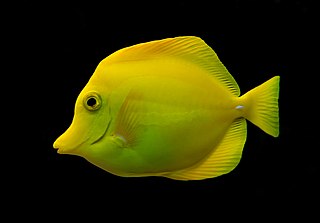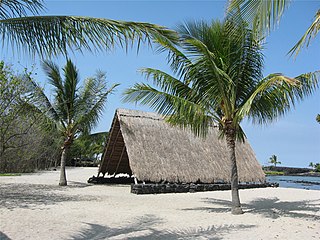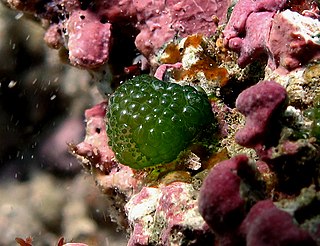
Algae is an informal term for a large and diverse group of photosynthetic, eukaryotic organisms. It is a polyphyletic grouping that includes species from multiple distinct clades. Included organisms range from unicellular microalgae, such as Chlorella, Prototheca and the diatoms, to multicellular forms, such as the giant kelp, a large brown alga which may grow up to 50 metres (160 ft) in length. Most are aquatic and lack many of the distinct cell and tissue types, such as stomata, xylem and phloem that are found in land plants. The largest and most complex marine algae are called seaweeds, while the most complex freshwater forms are the Charophyta, a division of green algae which includes, for example, Spirogyra and stoneworts. Algae that are carried by water are plankton, specifically phytoplankton.

The Houtman Abrolhos is a chain of 122 islands and associated coral reefs, in the Indian Ocean off the west coast of Australia, about 80 kilometres (50 mi) west of Geraldton, Western Australia. It is the southernmost true coral reef in the Indian Ocean, and one of the highest latitude reef systems in the world. It is one of the world's most important seabird breeding sites, and is the centre of Western Australia's largest single-species fishery, the western rock lobster fishery. It has a small seasonal population of fishermen, and a limited number of tourists are permitted for day trips, but most of the land area is off limits as conservation habitat. It is well known as the site of numerous shipwrecks, the most famous being two Dutch ships: Batavia, which was wrecked in 1629, and Zeewijk, wrecked in 1727.

The Hawaiian people practiced aquaculture through development of fish ponds, the most advanced fish husbandry among the original peoples of the Pacific. While other cultures in places like Egypt and China also used the practice, Hawaii’s aquaculture was very advanced considering the much smaller size of the area compared to others before it. These fishponds were typically shallow areas of a reef flat surrounded by a low lava rock wall built out from the shore. Several species of edible fish thrive in such ponds, and Hawaiians developed methods to make them easy to catch.

The yellow tang, also known as the lemon sailfin, yellow sailfin tang or somber surgeonfish, is a species of marine ray-finned fish belonging to the family Acanthuridae which includes the surgeonfishes, unicornfishes and tangs. It is one of the most popular marine aquarium fish. It is bright yellow in color, and it lives in reefs. The yellow tang spawn around a full moon. The yellow tang eats algae. The yellow tang has a white barb, located just before the tail fin, to protect itself.

Kelp forests are underwater areas with a high density of kelp, which covers a large part of the world's coastlines. Smaller areas of anchored kelp are called kelp beds. They are recognized as one of the most productive and dynamic ecosystems on Earth. Although algal kelp forest combined with coral reefs only cover 0.1% of Earth's total surface, they account for 0.9% of global primary productivity. Kelp forests occur worldwide throughout temperate and polar coastal oceans. In 2007, kelp forests were also discovered in tropical waters near Ecuador.

Coralline algae are red algae in the order Corallinales. They are characterized by a thallus that is hard because of calcareous deposits contained within the cell walls. The colors of these algae are most typically pink, or some other shade of red, but some species can be purple, yellow, blue, white, or gray-green. Coralline algae play an important role in the ecology of coral reefs. Sea urchins, parrot fish, and limpets and chitons feed on coralline algae. In the temperate Mediterranean Sea, coralline algae are the main builders of a typical algal reef, the Coralligène ("coralligenous"). Many are typically encrusting and rock-like, found in marine waters all over the world. Only one species lives in freshwater. Unattached specimens may form relatively smooth compact balls to warty or fruticose thalli.

Kaloko-Honokōhau National Historical Park is a United States National Historical Park located in the Kona District on the Big island of Hawaiʻi in the U.S. state of Hawaiʻi. It includes the National Historic Landmarked archaeological site known as the Honokōhau Settlement. The park was established on November 10, 1978, for the preservation, protection and interpretation of traditional native Hawaiian activities and culture.
Prymnesium parvum is a species of haptophyte. The species is of concern because of its ability to produce the phycotoxin prymnesin. It is a flagellated alga that is normally found suspended in the water column. It was first identified in North America in 1985, but it is not known if it was introduced artificially or missed in previous surveys. Toxin production mainly kills fish and appears to have little effect on cattle or humans. This distinguishes it from a red tide, which is an algal bloom whose toxins lead to harmful effects in people. Although no harmful effects are known, it is recommended not to consume dead or dying fish exposed to a P. parvum bloom.

Sicyopterus stimpsoni, commonly known as the Nopoli rockclimbing goby, oopu nopili, or Stimpson's goby, is a species of amphidromous goby endemic to Hawaii. This species can reach a length of 19.8 centimetres (7.8 in) SL.

Dictyosphaeria is a genus of green algae in the family Siphonocladaceae.
Mesograzers are defined as small invertebrate herbivores less than 2.5 cm in length, and can include juveniles of some larger species. The feeding behaviour of these small invertebrate herbivores is what classifies them as mesograzers. They are commonly found abundantly on Microalgae, seagrass beds, giant kelp, and coral reefs globally, since these are their main food sources and habitats. Their foraging behaviour is grazing on the organism they are living on, where there are typically masses reaching tens of thousands of mesograzers per meter of habitat. They experience predation from micro-carnivorous fish that help regulate the population of kelp and other common food sources of mesograzers by controlling the population of mesograzers; consequently, grazing is an important process linking aquatic vegetation to higher trophic level. Mesograzers show important top-down effect on marine communities, depending on the diversity and presence of predators. Mesograzers are typically overlooked in scientific research however their foraging effects have been suggested to have extreme effects on the population of their common food sources. They both positively and negatively affect macroalgal performance and productivity through grazing on algal, or through removing epiphytes. Mesograzers typically exist in spaces lacking enemies by inhabiting, therefore consuming, marine vegetation which are defended against more mobile, larger consumers through chemical defenses.

Limu, otherwise known as rimu or ʻimu is a general Polynesian term for edible plants living underwater, such as seaweed, or plants living near water, like algae. In Hawaii, there are approximately one hundred names for kinds of limu, sixty of which can be matched with scientific names. Hundreds of species of marine algae were once found in Hawaii. Many limu are edible, and used in the cuisine throughout most of Polynesia.
Lobophora variegata is a species of small thalloid brown alga which grows intertidally or in shallow water in tropical and warm temperate seas. It has three basic forms, being sometimes ruffled, sometimes reclining and sometimes encrusting, and each form is typically found in a different habitat. This seaweed occurs worldwide. It is the type species of the genus Lobophora, the type locality being the Antilles in the West Indies.

Chlorurus perspicillatus, known officially by the English name, spectacled parrotfish, given by professional ichthyologists and Ichthyology or uhu-uliuli as a well-established Hawaiian name for many hundreds of years, is a species of marine fish in the family Scaridae. Found only in the Eastern Central Pacific Hawaiian Islands, it inhabits lagoons and seaward reefs
Aureoumbra lagunensis is a unicellular planktonic marine microalga that belongs in the genus Aureoumbra under the class Pelagophyceae. It is similar in morphology and pigments to Aureococcus anophagefferens and Pelagococcus subviridis. The cell shape is spherical to subspherical and is 2.5 to 5.0 μm in diameter. It is golden-coloured and is encapsulated with extracellular polysaccharide layers and has a single chloroplast structure with pigments.

Gracilaria parvispora, also known by the common names long ogo, red ogo, or simply ogo, is a large species of marine red alga in the genus Gracilaria, endemic to Hawaii. It is highly sought after as an edible seaweed and is popular in mariculture and the marine aquarium trade. Also known as limu ogo in Hawaiian.

Heʻeia Fishpond is an ancient Hawaiian fishpond located at Heʻeia on the island of Oahu in Hawaii. A walled coastal pond, it is the only Hawaiian fishpond fully encircled by a wall. Constructed sometime between the early 1200s and early 1400s, it was badly damaged by a 1965 flood and fell into disrepair. A protected area, it was added to the U.S. National Register of Historic Places in 1973. An effort begun in 1988 is underway to restore the fishpond as a fishery, cultural, scientific, and educational resource.

Jennifer E. Smith is an American marine ecologist and coral reef expert who works at the Scripps Institution of Oceanography. Her research investigates how physical and biological processes impact the function of marine communities.














